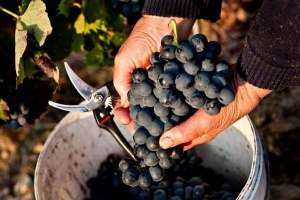Analysis: Grape varietals sold as bulk wine in Portugal

By Cruz Liljegren
Back in the 1990s it would have been commercial suicide to market Portuguese bulk wine by any one of the country’s unusual and lesser known grape varieties. But times have changed and consumers are getting ready to explore local varietals. Heritage and indigenous grape varieties are now very much in vogue, and luckily for Portugal they are abundant in all viticultural regions. Clean varietal wine does command a price premium, but rightly so, single-variety wines are more convenient when it comes to labelling and marketing.
Guide to Portuguese wine grapes
Here is our guide to the most common grapes used in Portuguese high-volume wine production which hopefully serves as a useful reminder to their individual characteristics. The grapes are listed in order of relevance to the bulk wine industry.
Aragonês (Red wine)
Portuguese Synonyms: Tinta Roriz (Douro). Aragonês has its strongest historical connection to the Alentejo region but due to its potential for quality wine it has spread to places such as Lisbon and Dão. It is today the most planted variety in Portugal and can produce wines of all quality levels. Recently it has become a popular variety in the fertile soils of Tejo (Tagus) where its yields are abundant.
Buyers tip: Aragonês sold in bulk is commonly more full bodied and higher in alcohol than Spain’s Tempranillo, despite being genetically identical.
Fernão Pires (White wine)
Portuguese Synonyms: Maria Gomes (Bairrada), Molinha (Setúbal). Aromatic and highly productive light-skinned grape planted throughout the country. Fernão Pires is the most widely planted white grape in Portugal, much due to its easy ripening and high yields. The combination between floral aromas of linden blossom and orange together with relatively low levels of acidity makes Fernão Pires a very quaffable white wine.
Buyers tip: Give an extra eye to the mg/L of SO2. The combination between susceptibility of oxidation and lack of ageing potential makes safe levels of SO2 important.
Castelão (Red wine)
Portuguese Synonyms: Periquita (Peninsula de Setúbal). Castelão is a very versatile and highly adaptable variety, it has therefore been a popular choice for a wide range of uses. It is particularly dominant in Setúbal, Tejo, Lisbon and Alentejo. As recently as 2010 Castelão was the most widely planted variety in Portugal. Today other grapes such as Aragonês and Touriga Franca are more in vogue.
Buyers tip: Always request a sample before purchasing wine from Castelão. Wines vary greatly depending on the soil and climate, from rich and full to light and transparent.
Síria (White wine)
Portuguese Synonyms: Roupeiro (Alentejo). Aromatic variety widely planted from the Douro in the north to the Algarve in the south. The fifth most planted variety in Portugal and second only to Fernão Pires on the white side. Commonly used in high volume wine production due to its high yields. Its wine has an average acidity and alcohol content and is often blended with Antão Vaz.
Buyers tip: Be aware that the aromatic qualities of Síria tend to decrease rapidly with age, we recommend to purchase as young wines as possible.
Trincadeira (Red wine)
Portuguese Synonyms: Crato Preto (Algarve) Tinta Amarela (Alternative name) Despite being a difficult variety to grow Trincadeira is popular in several regions such as Dão, Tejo and Alentejo. If the vigour of the plant is balanced it produces a wine that that is well structured, full bodied and rich in dark fruit flavours. Large producers tend to use Trincadeira as a blending partner, commonly with Aragonês.
Buyers tip: Request a sample before purchasing wine from Trincadeira. Wines produces from overly productive vines tend to get that herbaceous flavour that consumers generally dislike.
Arinto de Bucelas (White wine)
Portuguese Synonyms: Pedernã (Vinho Verde). High-acid variety with good vigour and adaptability. Arinto de Bucelas is the third most planed white grape in Portugal, just after Fernão Pires and Síria. Thanks to its ability to retain acidity even in hot climates it is popular in hot regions such as Alentejo. Valuable for producers and cooperatives for its ability to freshen up blends, even in warm regions.
Buyers tip: Despite generally being used as a blending component, clean varietal Arinto can be among the best white wines in Portugal.
Alicante Bouchet (Red wine) Portuguese Synonyms: Alicante (Alternative name). Alicante Bouchet is a red-fleshed cross that is used to darken blends. It was introduced in Portugal before the 1950s due to its quality potential, especially in Alentejo the grape has proven itself very well. If yields are controlled the wine from Alicante Bouchet is soft, deeply coloured and richly fruity. Alicante Bouchet is a grape on the rise in Portugal, partly due to its moderate but consistent yields in dry climates.
Buyers tip: Blends containing Alicante Bouchet should be successful in markets that demand deeply coloured red wines.
Caladoc (Red wine) Synonyms: Kaladoc (Alternative name). This Garnacha X Cot cross was obtained in 1958 by INRA (Montpellier) in order to produce a variety resistant to the vine disease coulure. The variety has spread rapidly, in Portugal the plantations has augmented dramatically, especially around Lisbon. From 1,115 ha in 2009 to 2,598 ha in 2014. Despite its average vigour Caladoc-yields are consistently high due to its resistance to coulure, making it a popular choice for high volume wine production.
Buyers tip: Caladoc has flavours and characteristics similar to Garnacha.
NB: The sources for this article have come directly from bulk wine producers in Portugal, Wine Grapes (2012) by Robinson, Harding & Vouillamoz and information from Wines of Portugal and Vinhos do Alentejo.
